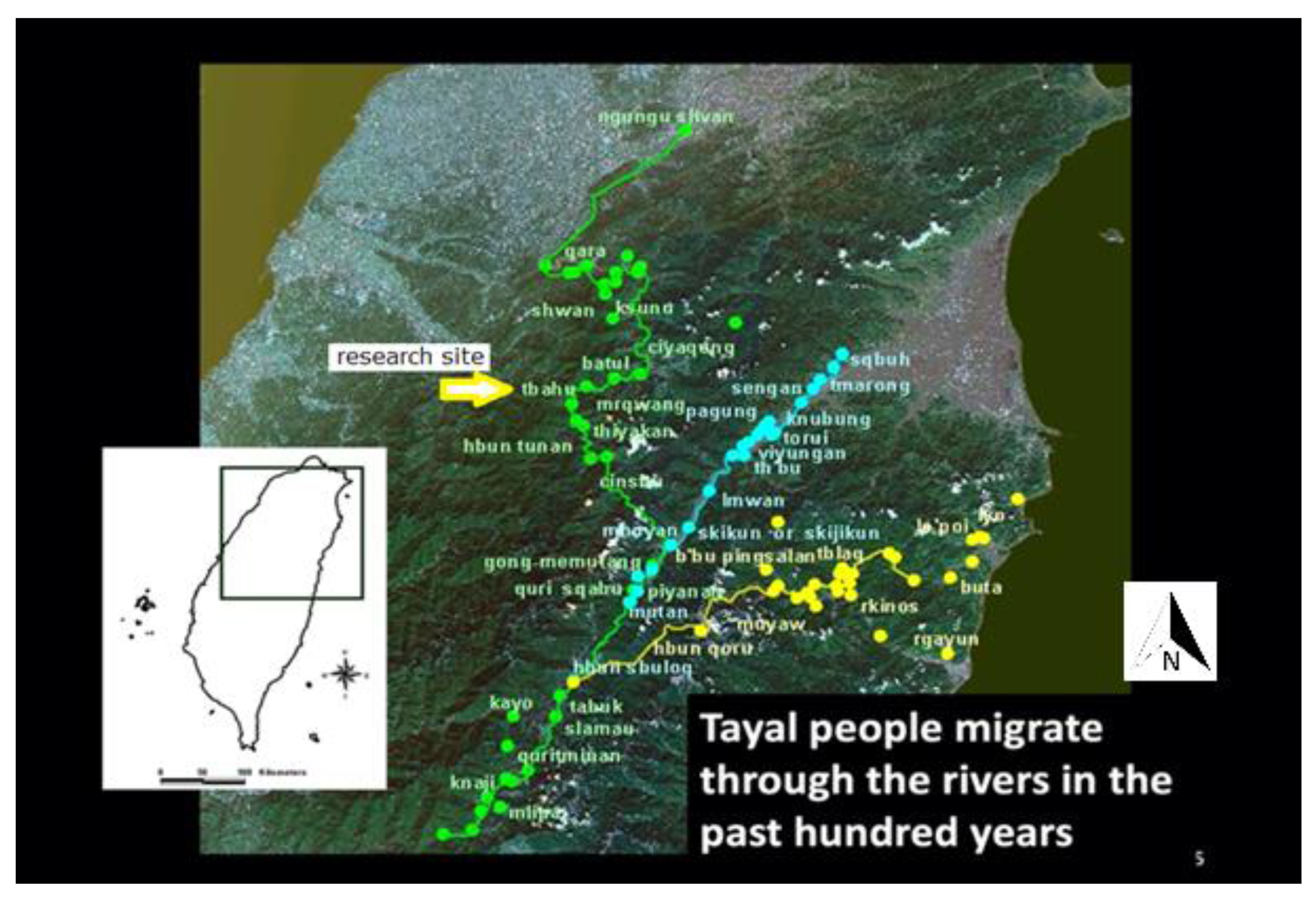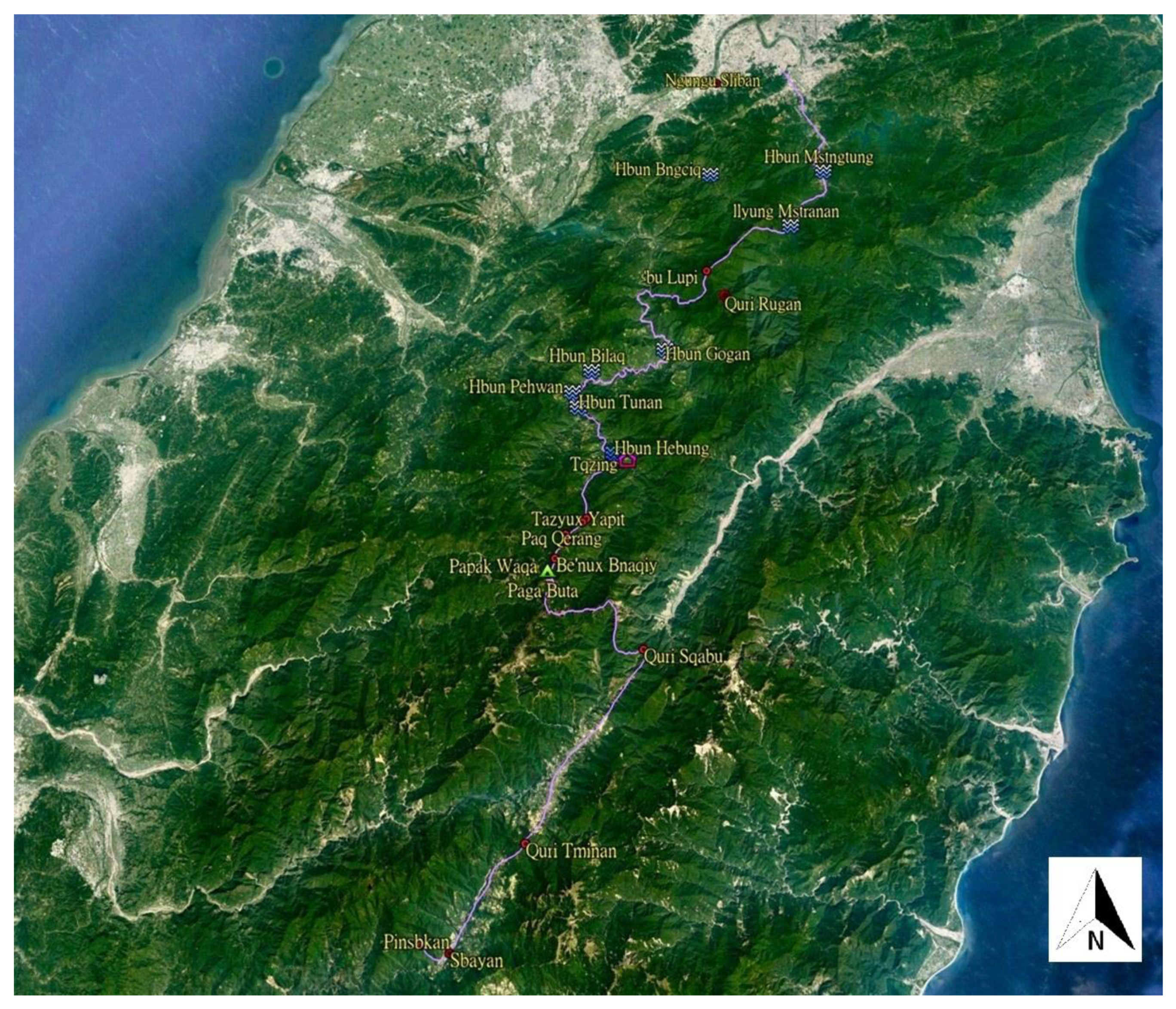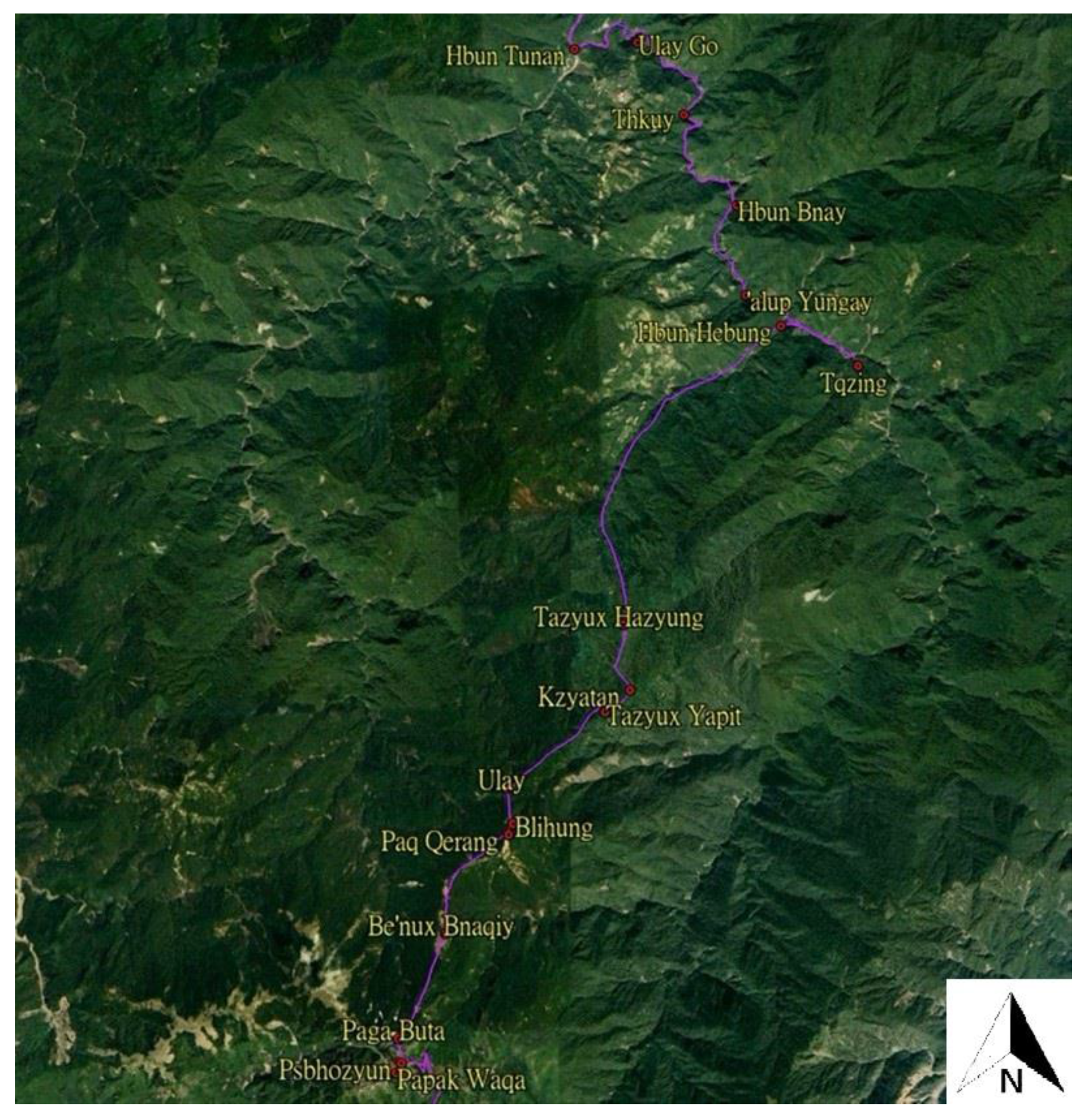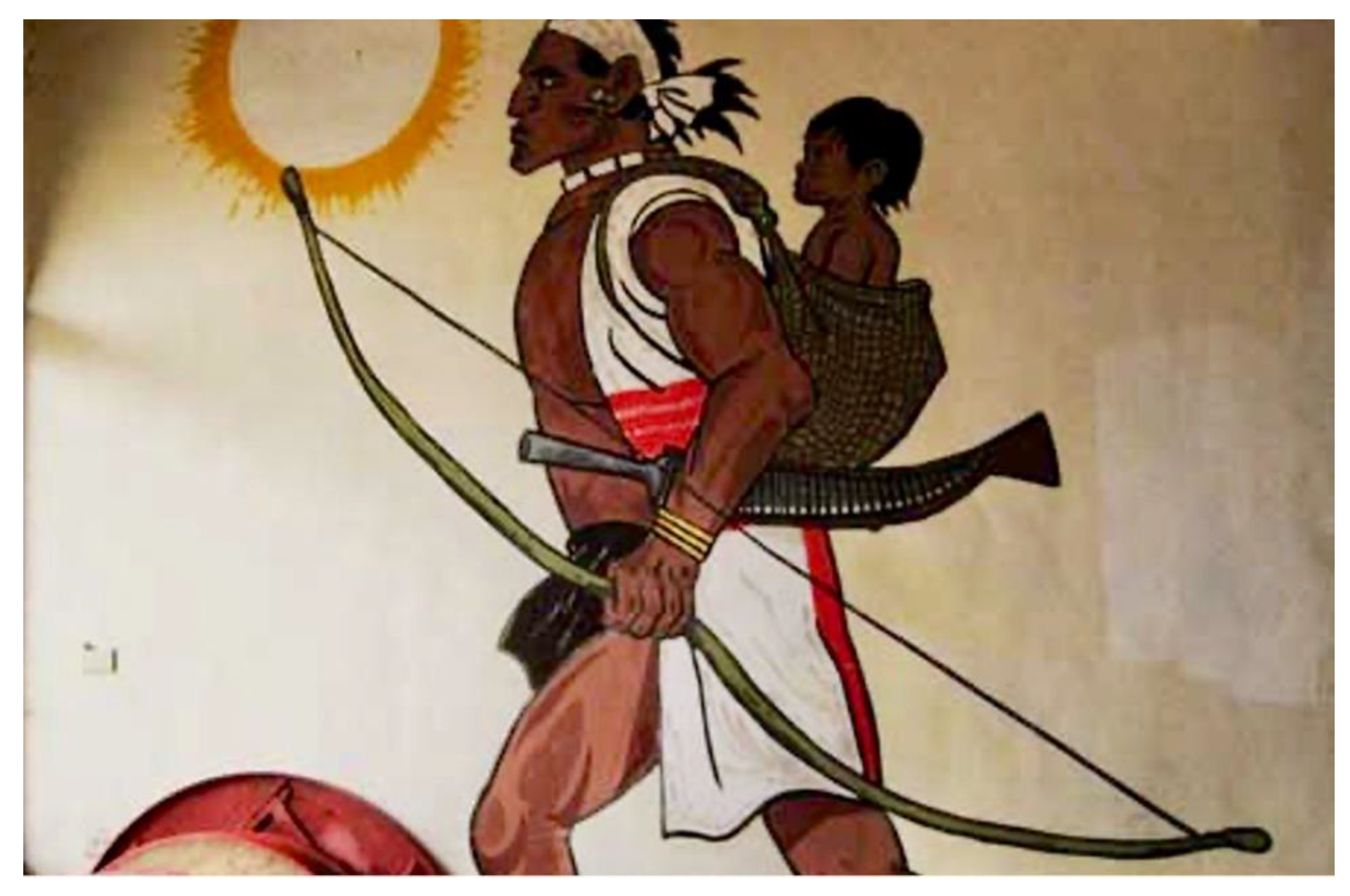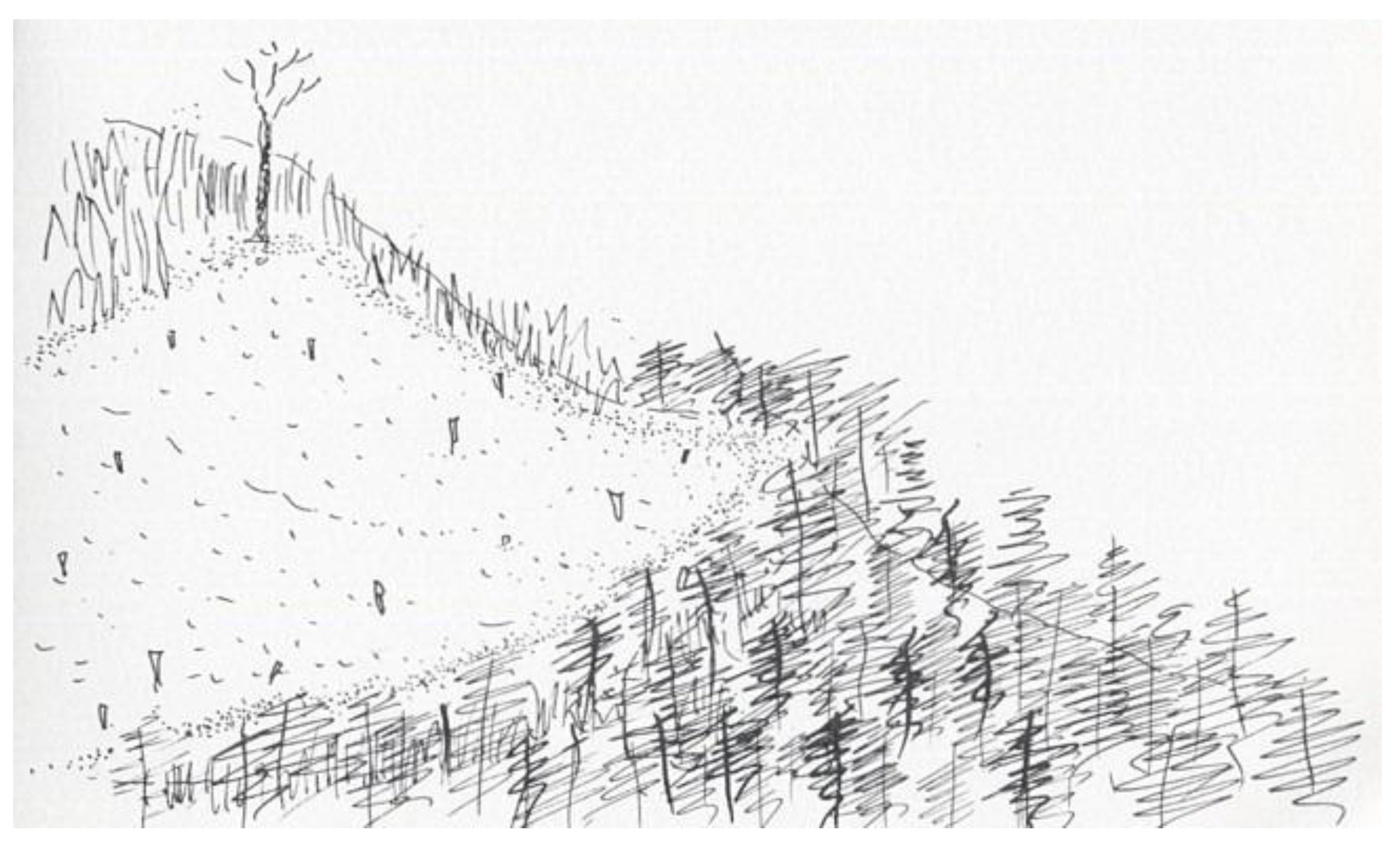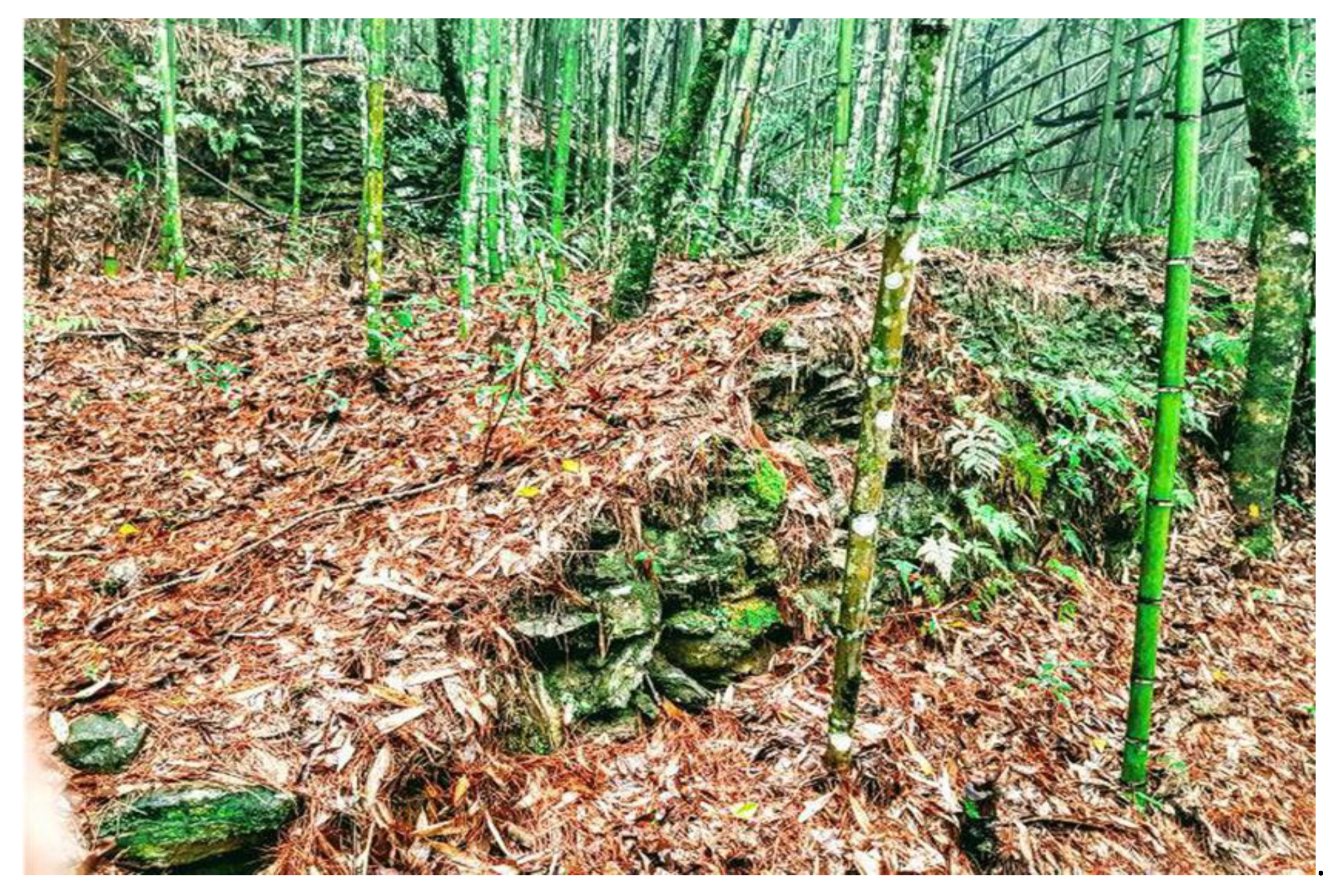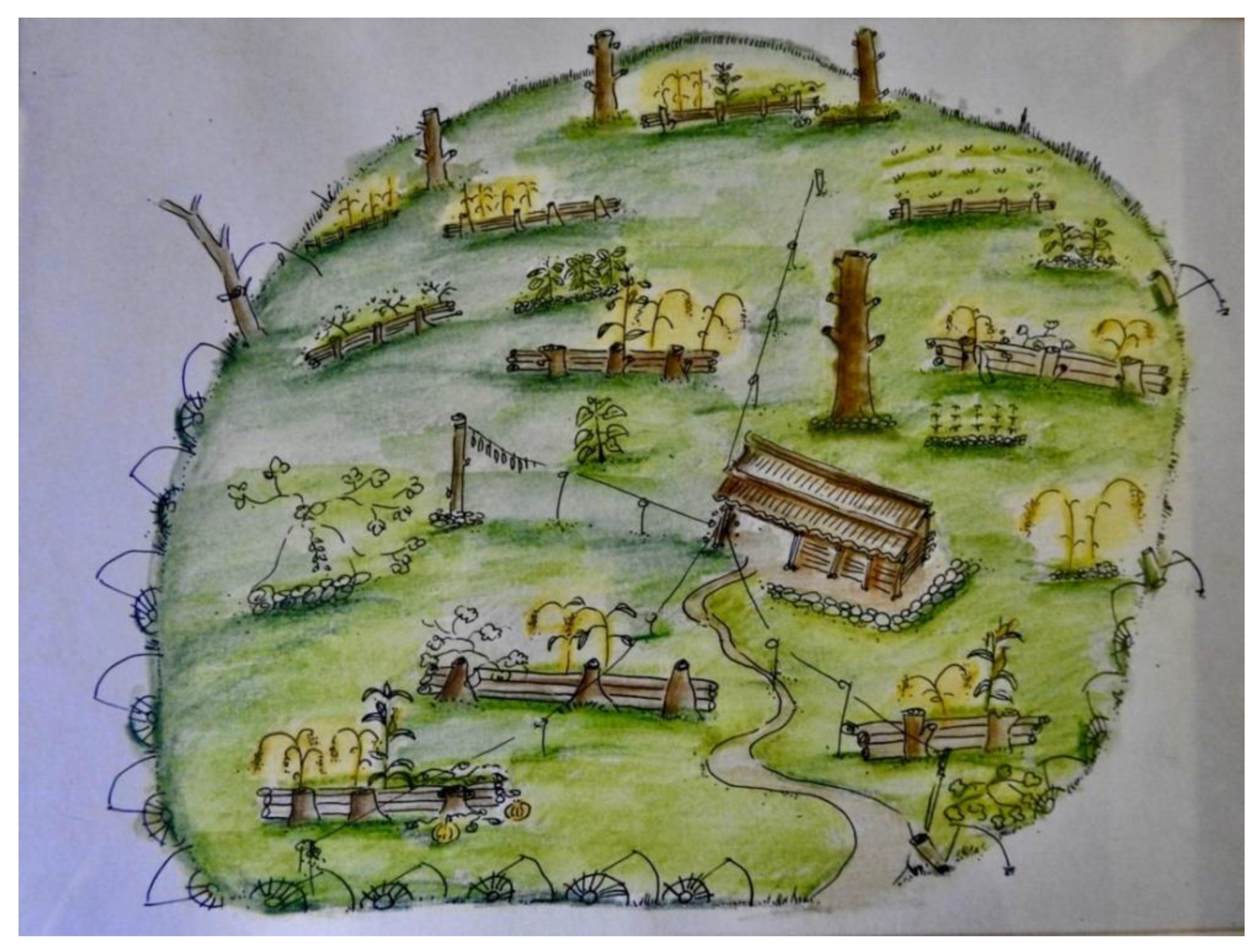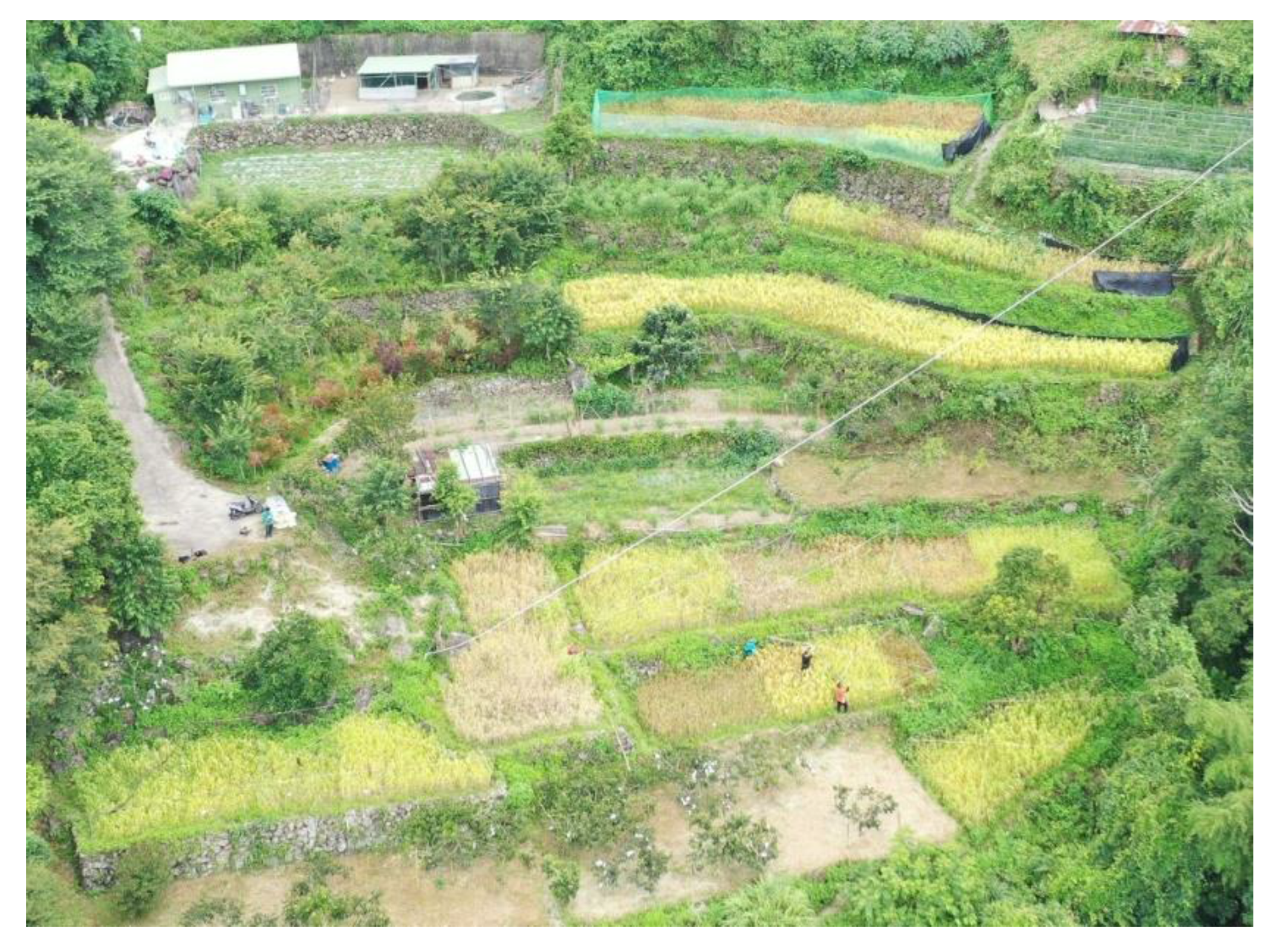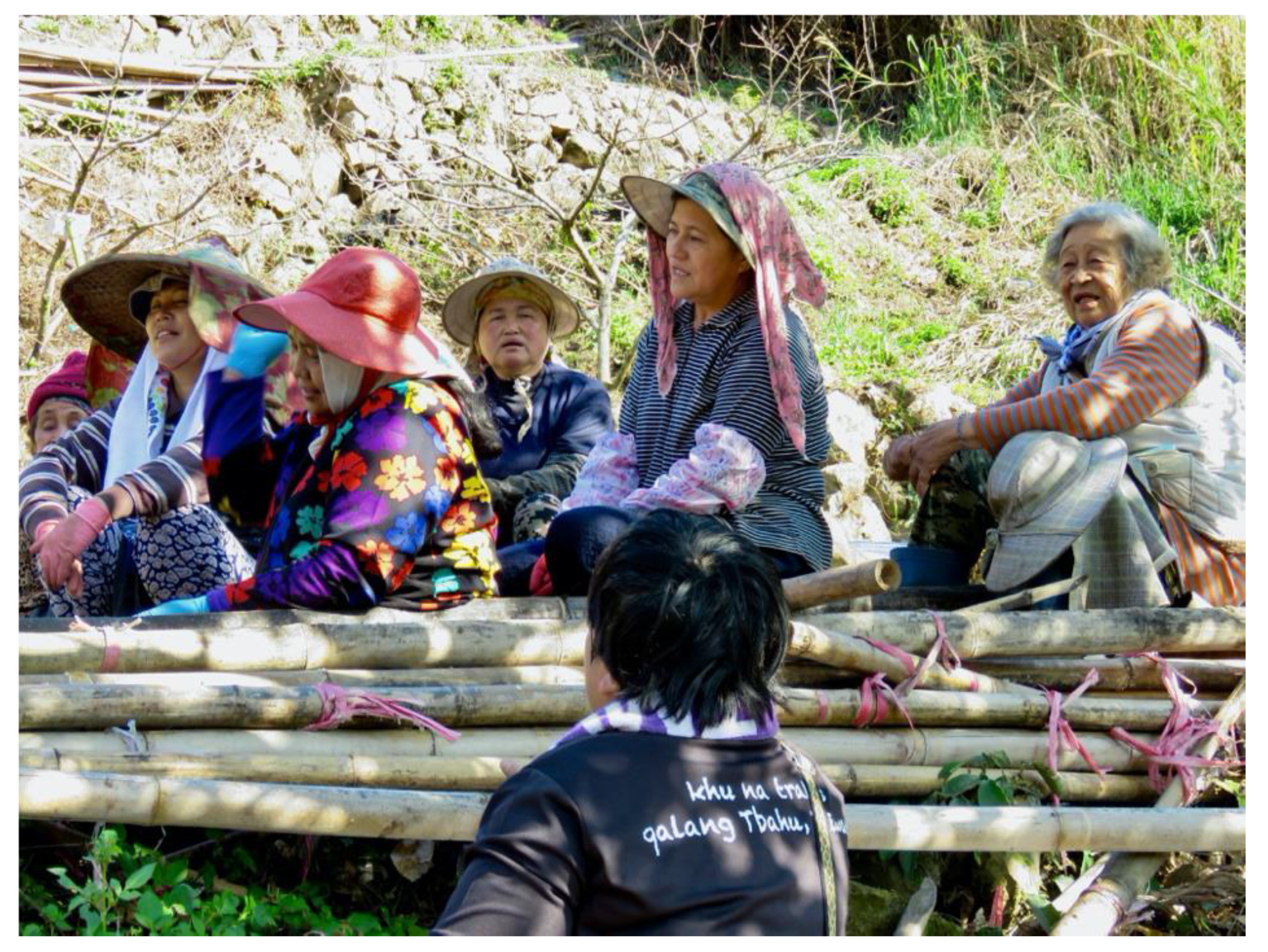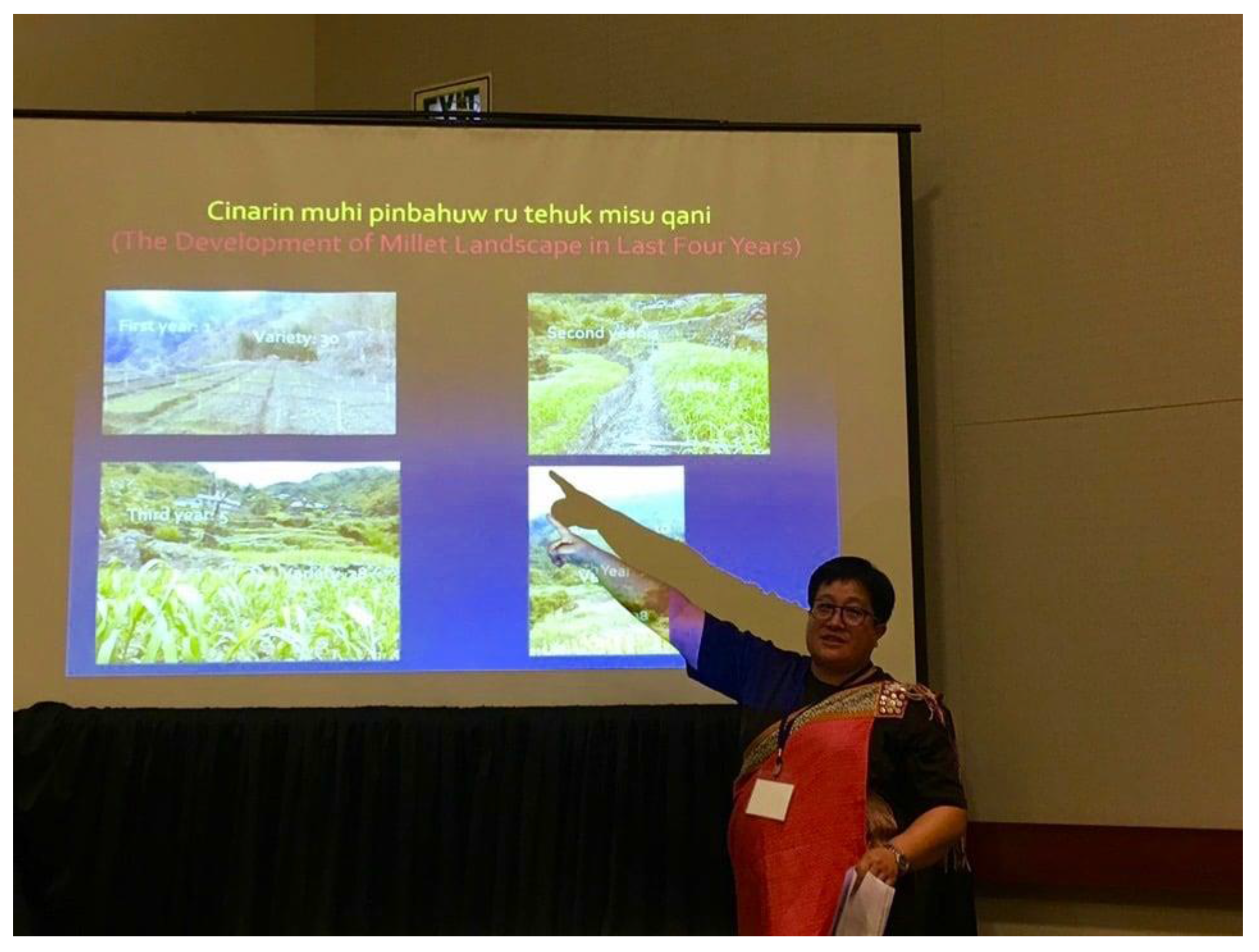1. Introduction
It is commonly believed that the mitigation of the climate change impact needs to “think globally and act locally”. The phrase is popular in international environmental movements since the 1980s that urges a common thinking of us living on the same planet and demands different allied actions from the local communities across the world to protect the earth. It indicates a common future of ours, in which we seek solidarity. While the global has been understood through many different languages and cultures, it is oftentimes perceived as the index of a hegemonic epistemology, for, unfortunately, these different forms of knowledge are not strong enough to contest with the dominant form of Western science. The global thinking based on scientific understanding often indicates a unitary voice that suppresses other forms of understanding the world. This paper argues for an alternative way of thinking based on indigenous knowledge without losing sight of facing the global crisis. It centralizes the role of indigeneity so as to challenge Euro-American/Western epistemological privilege and evoke the planet as a resilient and sustainable home for all sentient beings.
Indigenous resilience is a way of thinking. Social-ecological resilience theorists study institutions, systems, and individuals so that they can understand how they withstand, or why they succumb to, significant disruption. Resilience is regarded as the capacity of a system to absorb disturbance without flipping into a qualitatively different state [
1]. It is a normative concept and yet “the efforts to define it must be situated in the context of contested and evolving human interests and the uncertainties of human interaction” [
2] (p. 5). This kind of reasoning with a critical focus on “situatedness” entails indigenous perspectives of understanding resilience. Knowledge that is “situated” acknowledges social, cultural, and historical rootedness to specific locations, places, and life practices [
3]. It evokes an important aspect of indigeneity (for further discussion on the topic, see [
4]), which allows the original inhabitants of a place to make truth claims to practices, thoughts, science, logic and reason, verified by accumulated experience with their traditional lands, communities and transactions with the environment. Indigenous people are active participants, rather than passive observers, of the Earth processes. A thorough engagement with the concept of resilience from indigenous perspectives may lead to recognition of new dimensions of “ecosystemic processes that contribute to human flourishing” [
5]. We approach resilience from indigenous perspectives as a dynamic process of cultural and ecological adaptation and transformation in the face of global climate change, crucial to not merely the survival but thriving and flourishing of human and non-human species [
6].
This paper aims to articulate a meaningful response to recent calls to indigenous and local knowledge on food as a source of resilience in the face of global climate change. By retrieving the values and practices indigenous people of Taiwan, specifically Tayal women, associated with human and non-human ecologies, our collaborative work with the indigenous community explores indigenous resilience and its relevance to indigenous cultural knowledge and global environmental concerns. Pivoting on the “Millet Ark” action, a Tayal conservation initiative of the bio-cultural diversity of millets, this study revolves around issues of how Tayal communities adapt to the climate change, how to reclaim their voice, heritage, knowledge, place, and land through food, and how to narrate indigenous “counter-stories" of resilience and sustainability.
The paper is divided into four parts: (1) “introduction,” in which we acknowledge indigenous and international grassroots voices and review relevant literature; (2) “methodology,” which lays bare the significance of “walking” and “narrating”/“narrative” as methods, using the storytelling tradition of Tayal people as its backbone; (3) “ the cultural narrative of “Millet Ark,” which investigates indigenous foodscape and adaptation strategy as they are embedded in Tayal migratory history; shifting, fire-fallow and intercropping cultivation in the millet culture; the bio-cultural diversity of millets in the context of Tayal livelihood; and the Tayal women’s position and their connection to the land.; (4) “conclusion,” which prioritizes the indigenous knowledge as an essential part of contemporary discussions of resilience and reflects on the implications, limitations of the work, and further development of the research.
Acknowledging Tayal People’s Food Culture—A Review of Literature
Tayal people’s food culture reveals the depth of their understandings and knowledge about the local ecosystem and living places. This locally situated knowledge is, however, marginalized by the global capitalism as well as modern scientific knowledge under the proceeding of the Anthropocene. The traditional millet growing accompanied by multi-species cropping, shifting agriculture, rich knowledge of related rituals has powerfully demonstrated the people’s interdependence with nature and its advantage in living with the environment. Meanwhile, the tendency of monoculture cultivation, standardization, and mass production of agriculture has encountered unprecedented challenges due to the impact of global warming. It is high time that the world starts to reflect upon a new reappraisal of the value of indigenous ecological agro-knowledge.
The issue of traditional knowledge of agrobiodiversity is important, not only for Taiwan, but internationally. Berkes et al. argue that “traditional knowledge represents a summation of millennia of ecological adaptation of human groups to their diverse environments” [
7] (p. 269). Indigenous peoples have observed and survived the changes in their environment for thousands of years. In indigenous foodscape is embodied “a capital of knowledge that contains not only the simpler, ‘Is this good to eat?’ type of information, but also the codified essential information on how to respond to changes in the environment” [
7] (p. 281). Similarly, Zimmerer et al. emphasize “the value of locally sourced agrobiodiversity” [
8] (p. 6). Along these lines of thinking, our research aims to retrieve the value of Tayal community in Taiwan as a model of “locally sourced agrobiodiversity” in response to global climate crises. Recent work such as “The Effect of Cultural Practices and Perceptions on Global Climate Change Response Among Indigenous Peoples” by Bayrak et al. examines how Tayal people have been affected by climate-related disasters and argues that their ways of responding to climate crisis should be incorporated comprehensively into global adaptation and mitigation policy in the face of climate change (see [
9]). Nonetheless, little has been mentioned regarding the significance of the creation of a foodscape built on the relationship between indigenous people and the plants they cultivate for food. Our paper illustrates what is at stake when the relationship between indigenous people and the “first foods” they gather and cultivate is put at risk or interrupted due to the impact of global climate crisis (For a growing movement of foodways, human rights, and environmental justice, which is called the “local foods”, “food justice”, or “food sovereignty movement”, see [
10]). Our research focuses exclusively on a unique initiative of the “Millet Ark,” on which we have collaborated with Tayal farmers and practitioners. It is grounded in connectivity and encounter rather than in division and separation between academia and the indigenous. The indigenous is the subject of self-articulation, self-reliance, and self-affirmation rather than that of research and scholarship. It illustrates the co-agency, co-organization, and mutual aid/support of researchers and indigenous people in solidarity.
Traditionally, Tayal people regard their surrounding environment as their food reservoir and know how to use it. Forests and rivers are regarded as part of their foodscape rather than scenic sites of national parks. Employing the concept of foodscape, we aim to explore places and spaces where Tayal people acquire food, prepare food, talk about food, and gather knowledge and meaning from food. First developed in the field of geography and later extended in sociology and anthropology, this concept furthermore directs us to investigate the institutional arrangements, cultural practices, and discourses that mediate indigenous people’s relationship with food [
11] (p. 16). Climate change as it takes place across the globe brings about warning messages to urge us to reflect upon ancient ecological wisdom like Tayal’s food-based knowledges. Hsinya Huang notes elsewhere that national recognition of 16 Indigenous groups, the Tayal included, “marked a milestone in Taiwanese history” and provided “consistent and progressive formulation and execution of indigenous policies and coordinated planning for...the wellness of aboriginal peoples;” however, much remains to be done and indigenous groups continue to work “for self-reliance and self-affirmation” [
12] (p. 165) (see also [
10]).
Indeed, foodscape, which the Tayal call “nature’s refrigerator” in an intimate way, is a dynamic social and historical process of foodways, most relevant to Tayal people’s self-reliance, self-affirmation, and self-articulation. It embodies the people’s seeking, producing, competing, or sharing, and surviving upon the food in the places they have walked. The principles and mechanism of resilience can be best explored and apprehended from this dynamic process. Biggs et al. disclose the principles as to how to build resilience through maintaining diversity, managing connectivity, fostering complex adaptive system thinking, etc. [
13] In this paper, an attempt is made to explore Tayal foodscape as a source of resilience by examining these principles.
This paper draws on seven years (2013–2020) of research and field investigation on the traditional territory of Tayal people as well as on over a decade of collaboration between academics and Taiwanese indigenous writers, farmers, and practitioners, which has contributed to the development of a school of cultural study that links Taiwanese indigenous studies to global frameworks of native science and aboriginal cultures. As members of Asia-Pacific Observatory the Humanities for the Environment (h
fe) network (
http://hfe-asiapacific-observatory.nsysu.edu.tw/), we work with colleagues from other 8 Observatories across the globe to identify and explore how humanities contribute to solve global, social, and environmental challenges in the Anthropocene. In this paper, the indigenous concepts of resilience, foodscape and sacred geography, household and well-being, subsistence tradition and bio-cultural diversity, etc. are conveyed in the form of narrative scholarship as our way of striking a balance between discursive formation and field practices. There are competing historical and cultural narratives deeply embedded in the landscape that indigenous people created. By including Tayal stories and words to best communicate their relationship with the land and local places, we aim to speak to the fullness of indigenous experiences and practices in their home place.
3. The Cultural Narrative of “Millet Ark”
This paper focuses on the narrative of recovering millet in Taiwan indigenous cultural context, through which to find inspiration about adaptive mechanism in the face of climate change. It has to be told through the global-local interaction events concerning sustainability under the impact of climate change. The “Millet Ark” initiative involved by the authors exemplifies a social practice of collaboration between some indigenous people and academia. It starts from an international invitation but is based on a sincere support for local thinking. In 2013, Frederik van Oudenhoven, a Netherland environmental NGO organizer and a book-prize winner [
22], got in touch with us through the International Society of Ethnobiology’s secretary, Natasha Duarte. He was asked to establish a grassroots taskforce in response to climate change and in order to do so, he invited mountain-dwelling indigenous farmers from different countries to gather and discuss how climate change affected their environment as well as find a solution based on their local knowledges. This concept is founded on the presumption that the residents of the high mountains would sense the impact of climate change more acutely than those in the modern urban settings. This is also why some of them become victims and are known as “climate refugees,” for example, due to the accelerated effect of melting snow in mountains of the Himalayas or Tibet. Moreover, these indigenous farmers that reside long-term in the mountains must be able to react to the ever-changing natural environment, so they might have accumulated some local knowledge and created a culture around adapting to changes. This is what then we participate in the INMIP (International Network of Mountain Indigenous Peoples) [
23], a global grassroots network organization founded on this kind of dialogue and cooperation. We anticipate the creation of a positive and proactive grassroots force and the discovery of a way to contribute as a collective voice from indigenous peoples on the climate change issue.
In the spring of 2014, this grassroots network concept finally came to life. Yih-Ren Lin and Pagung Tomi, two of our authors, as well as a few members of Taiwan’s indigenous people, including Apuu Kaaviana from the Kanakanavu tribe, and Atung Yupas and Yapit Tali, who are both from the Tayal tribe, were invited to Bhutan to meet with mountain farmers from nine other countries and participate in a walking workshop. This process and outcome were later broadcasted by Taiwan’s indigenous television network [
24]. The walking workshop took us into the actual landscapes of the indigenous people in Bhutan, and the climate change issue was the main point of discussions. As we walked and talked, we pulled together different experiences and opened up an opportunity for mutually beneficial sharing among the different indigenous peoples. During the five-day event, we came up with a formal and public declaration on our stance regarding climate change [
25]. Our representatives and the International Institute for Environment and Development (IIED) then presented it at the international conference on climate change. In addition, our agenda this time also took us to the 14th International Society of Ethnobiology conference held in Bhutan. More importantly, as an indigenous woman from the remote mountain area in Taiwan, this was Pagung’s first time to hear, through a friend’s translation, the various farmers from around the globe and share their experiences dealing with climate change. She was moved and inspired, especially in terms of protecting traditional crops. This event later made her think about what she could do from her own cultural point of view.
In 2016, the group of Taiwanese representatives, inspired by the spirit of walking workshop, launched an “International Indigenous Ecological Farmers Alliance Conference” in Taiwan, as a response to the Bhutan Declaration, through collaboration with the International Society of Ethnobiology. All the countries that attended the conference created the farmers’ declaration together after the walking workshop. Then Taiwan’s representatives, Apuu Kaaviana and Yih-Ren Lin, brought it up during the Democratic Progressive Party’s Central Standing Committee meeting as a reminder to the elected party of the indigenous small farmers’ agricultural policy, as well as their determination to respond to the climate crisis together. As one of the indigenous representatives, Pagung decided to revert back to the traditional millet cultivation in her village, Tbahu. In addition to the eco-farmers conference, her action is also influenced by the following 2017 INMIP walking workshop in Peru, where indigenous farmers shared their experiences as they toured the world heritage site “Potato Park”, which shows the indigenous contribution of their local knowledge in conserving rich varieties of potatoes.
According to Pagung, millet is the shared traditional crop of the Taiwanese indigenous peoples, and thus there is a deeply-rooted connection between the cultural history and local knowledge of the indigenous groups. Millet demonstrates not only biological diversity but also cultural and linguistic diversity. In other words, millet is not just millet itself. It has to be connected to the land the people belong to. Therefore, the key issue is the operation of the millet field and related knowledge which includes the millet’s resilience regarding water supply, soil fertility and slope restriction. The fact that Taiwan is a subtropical pacific island no less with natural disasters such as typhoons and earthquakes presages the high probability of indigenous peoples’ migration activities and forms their dynamic settlement livings. Thus, the natural and social process of how the millet field is produced has to be dealt with seriously. As we engage ourselves with the social practices of millet field restoration, the whole traditional livelihood of the Tayal people begins to unfold itself. This livelihood illustrates how the indigenous people’s traditional migration, environmental change and the basic food demand have converged to the millet field operation, which we consider to be foodscape production. The following are our observations and findings from the social practices and process of the “Millet Ark” initiative, including (1) Tayal foodscape and hidden adaptation strategy in their migratory history; (2) shifting, fire-fallow and intercropping cultivation in the millet culture; (3) the bio-cultural diversity of millets in the context of Tayal livelihood; (4) the Tayal women’s position and their connection to the land.
3.1. Tayal Foodscape and Hidden Adaptation Strategy in Their Migratory History
We start our millet story from Tayal’s traditional migratory phenomenon. Our purpose is to understand the relationship between traditional food production and the ever-changing living environment. To the Tayal, migration is a common and communal activity, and more importantly, it is very possibly a result of lacking food supplies under the impact of climate change. In this paper, we learned from the Tayal elders about their migratory routes for the past four hundred years.
Figure 1 shows the route, which is a GIS (Geographic Information System) map guided by the past elder Masa Tohui. We drew the map mainly based on the contents of Tayal’s special ancient singing called “lmuhuw.” It is the Tayal’s unique way of telling their cultural stories. For an academic purpose of understanding “lmuhuw,” different aspects of translation are needed, which include the recording of ancient singing itself, transcribing it into Tayal language, the translating activities to other languages such as Chinese and English, and finally the collaborative interpretation amongst the authors. The outcome is mainly presented in the form of GIS map, which is to be viewed side by side with the singing passages and the accompanied interpretation. This is a way of deeper understanding about Tayal’s indigenous knowledge. Moreover, “lmuhuw” also contains the information about Tayal spatial memory, ecological observations of their living environment, adaptive strategies, and historical migratory social action responding to the environmental change. In a sense, the migratory routes and their mapping embody Tayal people’s foodscape, in which the landscape such as forests, rivers, millet cultivation lands, and households is perceived as the container of food production. It also illustrates how the changing environments affect Tayal people’s livelihood. Migration is a strategy of adapting to the changes.
Traditional singing of “lmuhuw” is the best oral record of Tayal migratory history. It is Tayal people’s narrative of their life, past, present, and future. The singing unfolds a deep culture of how the people respond to changes, which strongly links to their social institution. Tayal is a big tribe in Taiwan. It is divided into several subgroups with distinctive linguistic differences. Each sub-group called “llyung” (literally, the group of one river basin) has their own singing which contains the migratory history of the group. In her fieldwork, Pagung heard the singing from elder Yupas Pusing, recorded and translated it collaboratively with Atung Yupas and Watan Kahat. Her village Tbahu belongs to the Mknazi sub-group of Tayal people. Seeking the supplies of food is always the central concern of the migration, which is made explicit in the following passages from “lmuhuw”:
Pin’ara ke nqu bnkis na Tayal lkotas ta lkmButa, lkmYaboh, lkmAyan
(A reminder from lkmButa, lkmYaboh, lkmAyan, the three great ancestors of the Tayal people)
laqi! maha ni si ta kaki squ qbuli na bnkis ta qani lga, musa ta pskyutan qu hwinuk ta la. mosa ta yan nqu qara na maqaw pqqolan nqu llaqi ta kinbahan la, mosa si psqquli mita wagiq la. nanu yasa qu usa ru usa hmkangiy kzikan mamu balung, usa hmkangiy ’san mamu matuk tnga na pazyeh, teta musa mbhuyaw pslabang mqyanux squ tgzyumuw na rhzyal qu laqi mamu kinbahan, teta simu minblaq mita squ sinnyaxan na wagi, mtasaw na qsya. yan na ‘ali bzinuq mbhuyaw.
(Children! If we keep on guarding our original homeland, we may starve and become thin. Descendants! Perhaps we may even fight over mountain peppercorn just to fill our bellies, and sigh to the skies. Thus, you must rise up, and seek hunting grounds that you can weave through, fertile land that you can plow. Let future generations flourish on bountiful land, accompanied by sunshine and clear rivers, and grow as quickly as a flying arrow).
This passage suggests the impact of environmental change that causes shortage of food. Planning to migrate seems to be an alternative for the survival and thriving of the group. It also shows that the decision is made in a thoughtful way and with courage. Apparently, unlike the modern compulsory relocation project determined by the government, Tayal people have the free will to carefully choose where they are going to stay and they do it with sophisticated preparation.
Furthermore, Tayal people migrate in solidarity and recognize themselves as oneness despite the coming split due to migration, as the next passage indicates:
qutux lozi ga, laqi! usa ru usa blaq pgwayaw squ son mamu mtasaw nqu llyung, laxi usa mkkiy nqu qlcing, laxi usa pqeway na pakaw. kya qu qmayat squ tluqiy, ini ga blaq balay pgwayaw qu tunux na bubu, teta simu minblaq mbhuyaw.
(Also, children! Find a heart as clear as water, do not become cold and indifferent to each other. Do not cut off contact using thorns and fences. If there is someone you like, choose wisely and determine the bloodline, so you may thrive and grow in strength).
Some other “lmuhuw” passages show the Mknazi’s migratory routes over the past four hundred years (
Figure 2). They identify Quri Sqabu, Papak Waqa, and Hbun Tunan as significant landmarks and as integral to the Tayal territory. In the Tayal creation story, “Pinsbkan” is their ancestral home, meaning “birthplace of the rock cracks”. It is a metaphor for all the future generations moving north along the rivers and mountain ridges, expanding their territory, finding fertile lands, and dividing into various subgroups. In this paper, we focus on how one of the subgroups Tbahu village’s ancestors migrated to the group’s current place as well as their geographical knowledge related to the environment.
Figure 2 maps the Mknazi migratory route of Pagung’s ancestor, IkmButa, from the Tayal origin place, as it is recollected from the traditional singing of lmuhuw as follows:
rasun lkmButa mkura sa quri Sqabu
(Chief IkmButa led his people toward the mountain saddle, Sqabu)
mbiyaq squ son mha hbun na Mhebung
(go downward to the so-called rivers’ confluence, Mhebung)
Tqzing
(the first village name from the three ancester brothers’ split point)
usa ru usa mbiyaq squ hbun Tunan
(continue to go downward to the rivers’ confluence, Tunan)
hbun Pehwan
(the rivers’ confluence, Pehwan)
hbun Bilaq
(the rivers’ confluence, Bilaq)
hbun Gogan
(the rivers’ confluence, Gogan)
ru usa squ son mha llyung Mstranan
(continue to go to the riverbasin of Mstranan)
ru llyung Mstngtung
(go to the riverbasin of Mstngtung)
Chief IkmButa is one of the three ancestral brothers and the direct ancestor of Pagung’s villagers. In Tayal vocabulary, quri and hbun respectively mean the mountain saddle and the rivers’ confluence. Both are the key landmarks for the Tayal to navigate the mountains. Hundreds of small place names describe their ecological observations along their migratory route. The observations embedded in the place names are evidence of their knowledge regarding how to adapt to the changing environment. This knowledge is vital to their safety and food supplies. Examples abound as shown in
Figure 3 and
Table 1.
Moreover, any migratory action is a careful collective plan that includes many preparations in advance, such as the probing of possible residential sites and their land condition for future food sources. In “lmuhuw,” as the phrase “so-called” implies that the route had been well explored by the heralds before the group set out on their journey. The Tayal remember their ancestral migration through “lmuhuw,” which tells stories of not merely survival but flourishing of the indigenous groups. As diverse, healthy, and sustainable food and cultivation systems provide needs of present and future generations, the Tayal continue to thrive and flourish. It is worth noting that without aid of modern technology, the Tayal ancestors have retained their ecological and geographical knowledge through singing their “lmuhuw”. The reason for the migration is very much connected to the impact of environmental change. How to survive on a harsh migratory journey was strongly connected to the millet culture, as examined in the following sections.
3.2. Shifting, Fire-Fallow, and Intercropping Cultivation in the Millet Culture
Tayal people have a myth (
Figure 4) about shooting the sun; this story is evidently the people’s response to climate change in natural history, which also has to do with millets. Legend says that a long time ago, two suns appeared in the sky and caused a great drought. The Tayal chose brave warriors to carry infants on their back and go where the sun was. During the long journey, the children grew up and finally shot down one of the suns to restore life to the earth. Throughout the long journey, each warrior kept a tiny tube in his earlobe, and inside the tube were millet grains. Millets were to be sowed on their path, so that the warriors could find their way home and meanwhile secured enough food for their travels. The elders often repeat this story, as if to tell us that climate change is not a modern occurrence.
Millet plays an important role in the Tayal migratory epic. According to the elders, traditional millet cultivation has three important ecological secrets: first, fire-fallow cultivation; second, shifting cultivation; and third, intercropping. Millet is a drought-tolerant crop so it does not need a complex irrigation system, and it is often grown on uneven lands and steep hills (
Figure 5). The changes to agriculture due to limitations of the topography show Tayal people’s adaptability to mountain life.
The Tayal practice fire-fallow cultivation because they do not separate forestry from agriculture as modern land management would. When the Tayal ancestors first arrived in a new location, they would clear up trees and weeds, and then burned them. Next, they would mix ashes with the dirt and use them as a kind of natural fertilizer and start to farm. In the fire-fallow process, they used fire very delicately. Determining wind direction and when to ignite the fires are skills necessary for fire-fallowing; otherwise it could lead to devastating forest fires. Through this farming method, the Tayal could artificially turn their woods into fields and, more interestingly, recover their fields into woods.
This use of land brings us to a discussion on shifting cultivation. Realizing how long-term farming would make the land less fertile and make it hard for the millets to grow, the Tayal practiced shifting cultivation. Unlike modern agriculture where farmers keep adding fertilizer, the Tayal ancestors chose to let their land rest. Letting the land rest is a special feature of the millet’s shifting cultivation. Moreover, while they let the land rest, the Tayal grow Makino bamboo (
Figure 6), which they call “luma” or they grow Formosan alder (
Alnus formosana Makino), “iboh”. The Tayal people are very dependent on Makino bamboo; bamboo shoots are a source of food, and bamboo stem is used for construction. As for alder trees, they are a heliotropic plant that form symbiotic relationships with the rhizobium that grows in its roots. Rhizobium has the ability to fix nitrogen into the soil, so once they burn the alder after a few years, the land retains the nitrogen rich soil. Thus, through implementing shifting and fire-fallow cultivation, the Tayal people have created a complex adaptive ecosystem. They are a part of nature, and not apart from it. This could be what the North American Chief Seattle truly meant when he said that man belongs to the earth.
Intercropping is still another special feature of the millet fields. Instead of saying that the millet is the only crop, you might say that it is the flagship crop behind the creation of the Tayal homeland. Traditionally, besides the millet, in a millet field there are also sweet potatoes, taros, corns, pigeon peas and other different crops. Other grains and beans are grown amongst the millets, creating a nutritious diet for the Tayal, which contains protein-rich beans as well as starch (
Figure 7). Furthermore, these crops also attract animals like birds, mice, and wild boars. The Tayal set traps for the animals in the fields, adding a new source for animal protein. The elders told us that in the past, millet was very rare and had to be carefully protected. One night, the person guarding the millet field heard a clanking sound and thought it was a thief. But upon listening carefully, he found that the noise was coming from beneath the ground and it was the sound of the sweet potato roots expanding. These roots created crevices and space in the soil, allowing the millet to sprout. The story of sweet potatoes helping the millet grow was a touching tale of ecological symbiosis to our ears. The concept of an ecological network has already long been passed down in the indigenous culture. According to the Pacific Island indigenous myth, peas, corn, and cassava are three sisters. Cassava loosens the soil underground to let Corn grow vertically upwards, and Peas can grow along the cornstalk, creating an interdependent/intercropping ecosystem. The intercropping tradition convey strong ecological significance while the Green Revolution of modern agriculture endorses mass production of a single crop, going against the balance of nature.
In short, fire-fallow, shifting, and intercropping cultivation in the Tayal millet culture formulate a harmonious union of farming and the ecological system. This is most likely a result of long-term evolution and adaptation. Even more noteworthy is that this kind of codependency and mutual support is especially important under the context of climate change. As a major staple food, millets facilitate and shape the dynamic development of Tayal’s traditional territory, in which the responsive strategies to climate change reside.
3.3. The Bio-Cultural Diversity of Millets in the Context of Tayal People
When Pagung began to grow millets at home in 2016, she had little experience and received many skeptical eyes from the villagers. The village Tbahu like many other indigenous villages in Taiwan has gone under the influence of market economy which means farmers got used to growing cash crops. Tbahu is a famous and an important site for growing tomatoes to supply the urban area like Taipei, the capital. Few villagers would recognize the value of growing back the traditional crop, millet, because they do not find it worthwhile in terms of income. Traditionally, millet is their staple food, but the cultivation habit has been replaced by rice paddy since Japanese colonized Taiwan in 1895, in order for the government to fix them in one single location and prevent them from migrating. Therefore, this village has abandoned millet growing for quite a long time. Under such circumstances, Pagung’s millet dream was hard to realize; nonetheless, she managed to find millet seeds collected by researchers from other Tayal territories and preserved in the government’s seed bank. She also found a piece of land and began to grow them.
She received little attention until one day an old woman visited her millet field. Pagung was surprised by her appearance and asked her why she was here. The old woman started to tell stories about millet, reminding her of many childhood memories. She began to tell Pagung knowledge related to millet including the long- lost vocabulary about the names of different millets, rituals, and agricultural practices to take care of the millet field. Pagung started to interview the elders in the village, including her own father, and recorded their knowledge about millet.
Table 2. Ethno-classification of millets known by Tbahu villagers shows the vocabulary of millet varieties.
Seven different varieties of millets have been identified, each carrying an indigenous name, based on their colors and other characteristics. Indigenous peoples preserve them by growing and caring them in their environment and everyday practices rather than in the seed bank as the main-stream bio-science does. In this in situ way, language and culture of the millet accompany the biological diversity. Pagung witnessed the whole process of recovering Tayal millets in the past 5 years, at different stages of growing millet, for example, clearing the field by slashing and burning, seeding, weeding, thinning, bird-repelling, and harvesting. Pagung’s people start to plant the seeds by observing the blossoming of mountain cherry trees around February but the phenology is now seriously challenged by the climate change. Moreover, while slashing and burning practices used to be regarded by colonial Japanese experts as out-of-date agriculture, they recovered sophisticated knowledge through their practices, which we will explain later in the migratory section. Rituals at different stages represent indigenous people’s relationship with the land and more broadly their cosmology. Knowledge related to naming, resources usage technology and skills, social institution, spirituality, belief, and worldview are richly embodied through Pagung’s long-term social practice by growing millet. The cultural and social life surrounding millet would not be possible if millet seeds were only preserved in the low-temperature refrigerator under the scientific project of a seed bank for biological diversity.
Pagung’s initiative of recovering millets has gained support from a small grant of Ministry of Culture as well as collaboration from the universities. Over the years, one plot of land has grown up to ten plots and become a significant landscape of millets in the village. Attracted by the landscape, more villagers came to serve as volunteers, especially the older women. They revealed stories about millets. Story-telling then becomes a common way of life when there are significant rituals held for millets such as seeding or harvesting. These stories include villagers’ collective memory and knowledge related to millets. It also constitutes and reconnects the relations of the villagers to their traditions surrounding the land and their ancestors.
3.4. The Tayal Women’s Position and Their Connection to the Land
Millet culture is rapidly disappearing under policies that encourage the modernization and grounding of Taiwan’s indigenous peoples. In losing traditional cultivation culture, the biggest problem is the loss of the connection to the land and adaptability to environmental changes. When we joined the INMIP’s walking workshop seven years ago, we gradually felt the importance of the grassroots force and traditional ecological knowledge to the climate change response. Thus, we started the “Millet Ark” Initiative. This movement was started by Pagung in her own village, Tbahu, and is a preservation initiative regarding the bio-cultural diversity of millets.
Taiwan has over a hundred kinds of millets. Moreover, different villages have different traditional uses of millets. Millets can be steamed, made into congee or cakes, used for marinating meat or making wine; each village has their own methods. Pagung’s village has not grown millets in over thirty years, mostly because the need for modern currency caused them to switch to cash crops. The traditional phrases, rituals and skills and social practices related to millets all disappeared when they ceased to grow them. The preservation of millets means physically growing them on their fields, not resorting to any scientific methods including freezing seeds. Upon return from Bhutan in 2014, our team has been focusing on bringing back millet cultivation, especially in Pagung’s village. Pagung remembered that the seeds of different varieties were gathered from various Tayal village locations and stored by the government. So, the first step was to get these seeds back and find land in the village to plant the millets. Thus, the millets grew from one field to over ten different fields over the past years. The number of participants increases from one person into an entire group of indigenous cultivators.
Continuous support came from the elderly women. They were the first villagers to approach the millet field, and they were the ones who started to share their memories of millet growing with Pagung. They shared many words related to millet, including the names of different millet types, the words for different stages of cultivation, songs, rituals for sowing, harvesting, and storing, as well as millet-related stories. The participation and memories of these women added a lot of cultural and social meaning to our “Millet Ark” initiative. Traditionally, the Tayal’s patriarchal society demands women to be less vocal in public, but this does not mean that they are not proactive in the society. The millet preservation movement not only let us realize that women have an active role in the millet cultivation process, but also that a lot of the ecological knowledge is demonstrated in their everyday practices.
Table 2 discloses a part of this knowledge. More significantly, the efforts of the women have expanded the field of millets from one piece of land to a landscape of traditional food production (See
Figure 8).
The millet landscape is a soothing place, for it recalls the elderly women’s cultural memories, which include many past feelings that were erased by modernization. Through physical labor and contact to the culturally-meaningful millet, the process brings forth an intimate connection between the individual and community, between people and the earth, and between people and the spiritual presence. This landscape is not “no human being’s wilderness.” On the contrary, the labor and participation of the people enriches the land with an emotional connection, adding to the meaning of “Tayal country.” “Tayal country” basically refers to the socio-ecological system created through the Tayal people’s interactions with nature. In this there are not just material but also biological and societal ecological services. This is the force that made the women willing to approach the millet field and gain a kind of healing. We have participated in Tbahu village’s sowing, harvesting, and storing process and simultaneously felt a kind of harmonious rhythm. The healing and affective impact of this millet initiative can never be overestimated. Unlike cultivating cash crops, millets bring smiles, laughter, and rest. This is because it is not done for monetary gain and these women forge a sense of community and a bond of common livelihood through the childhood memories that they rediscover and share. They plant step by step on a terrace field, and the sowing work is finished quickly (
Figure 9). As a consequence, the mothers went to rest in the shade, and someone started to hum traditional tunes of rimuy-rimuy-rimuy-so and voices soon joined to make a chorus. This is a soothing scene, in which re-growing the millet balances out the stress of work and distance between people and the earth caused by the logic of a capitalist market. Traditionally, millet growing is accompanied with the rhythm of seasonal change, the ecological interaction of the land, soils, and non-human species, the collaborative work across the age and gender of all family members, and the rituals to connect humans with nature as a whole. In our millet narratives, women take the lead to restore knowledge about millets and by extension, usher the community into the sustainable and resilient future through the present action of “Millet Ark”.
The millet story comes to a symbolic performance when a food rights panel based on this millet initiative was presented in the 2019 annual meeting of the American Studies Association in Honolulu, Hawaii. The panel titled “Building Caring Solidarity Economies: Food Sovereignty, Community Solar, and Gastronomies of Place” conveyed indigenous perspectives in building caring “solidarity economies” around food and energy systems, with Pagung being the primary voice of indigenous vision and wisdom [
26]. As a Tayal conservation initiative, the “Millet Ark” features indigenous self-determination and place-making and brings to life the traditional foodscape which would otherwise be consigned into oblivion.
The international conference is not merely an intellectual event but a long walk, which will be continued. This walk is about indigenous knowledge and its relevance to climate change, from the ancient to the contemporary. Our local efforts of almost seven years had a chance to be presented internationally (
Figure 10). The purpose of sharing our story was to explain one thing, which is a variation of the average conservationist’s slogan, “Think Globally, Act Locally.” Our movement emphasizes that “Think Locally, Act Globally” is just as important. Global and local conservation efforts are mutually dialectical, and localized thinking shows the importance of traditional ecological knowledge. Our seven years of practical work has reaffirmed the value of the ancient knowledge accumulated by Taiwanese indigenous peoples in regards to the current global crisis. In the face of environmental changes, people must adapt and learn in accordance with nature. Our initiative delivers not merely the biological or cultural characteristics of the millets, but how millet growing entails an understanding of the environment.
In Taiwan, millets are the flagship species of the Tayal people’s traditional crops. Tayal elder and practitioner Pagung’s experience exemplifies how the indigenous people in the trans-Pacific context forge practices that invoke the concepts of traditional knowledge, native science, resilience, and foodscape. In one of the walking workshops later held in the mountainous Tayal villages, Pagung sang, in indigenous words, a song about the migratory journey of her Tayal ancestors, a group of whom walked across the sacred mountains of Papak Waqa and settled in Mknazi as “those who come first.” It is in this historical process of migration and settlement that Tayal people develop ways of knowing and understanding the complex Austronesian world of islands, mountains, waters, and food, which the later settlers from the Chinese continent began to appreciate only recently. This knowledge involves land management, relationship between human and non-human beings, foodways, ceremonies and rituals, belief and practices, as well as the connection between the place and seasonal forces in their everyday life, which provide an intellectual stimulus to this paper.
4. Conclusions
This paper illustrates Tayal’s millet field operation as their foodscape, in which indigenous resilience principles reside. Some of these principles coincide with those explicated in the work of Biggs et al. [
13]. Firstly, the Tayal millet foodscape sustains bio- and cultural diversity of the Tayal community. Millets have vanished for over three decades in Pagung’s village. However, the action of Millet Ark Initiative has significantly recovered the varieties of millets used by the villagers in the past. Not only are the biological varieties recovered, including the varieties of millet crops (intra-species) and of mixing crops in the millet field (inter-species), so is the traditional millet vocabulary, which signifies cultural and linguistic diversity of the Tayal.
Secondly, the millet foodscape manages connectivity. Tayal’s historical migration should not be regarded as a simple act of moving in space. The shifting agriculture of millets and the grand migration, remembered through the singing of “lmuhuw”, are both responses to the environmental change. In such a manner, humans are connected to the changing environment and react to it. The migratory movement also means more connections to other non-human species that include bamboo, alder, new lands, and places. All these are involved and linked in a wider sense of Tayal ecological world.
Thirdly, the millet foodscape monitors feedbacks. The shifting agriculture closely linked with millets growing involves feedback process of crops (millet and other mixing crops)-fallow-bamboo-(or alder)-crops in connectivity. This process has to be combined with the active human agency of slashing and burning the bamboo (or alder) for increasing the nutrients of the soil. In this way, Tayal’s millets growing does not need the chemical fertilizers but use the ecological services in the environment as the Tayal are keen on responding to feedbacks from the environment.
Fourthly, the millet foodscape fosters complex adaptive systems thinking. The historical migratory routes and experiences embody many incidents of trial-and-error to establish an adaptive system for Tayal’s survival. The thinking behind these efforts include the navigation skills, food foraging, ecological observations about finding safe residential sites and the social institutions related to solidarity. Finally, it expands participation into a widening circle of associations. In the past seven years, the members of Millet Ark Initiative have connected global network action of climate change to the local context and provided local knowledge and thinking in return. The global-local interaction has been significantly increased through the women’s practices led by Pagung. In view that women’s voice has largely been silenced in traditional Tayal society, the Initiative has not only broadened the participation on the international level but also crossed over gender boundary.
There are other boundaries to transcend including that between the human and non-human. The indigenous ways we convey through our narrative embodies an entangled world of human and non-human beings, a “meshwork”, which in effect creates “new possibilities for the flourishing of life along diverse lines” [
27] (p. 320). Indigenous ways are different from knowledge of Western science as they are “conservation-oriented practices of ecosystem, which tend to be grounded in their humans-as-part-of-nature worldview,” a wider community of beings that includes animals, plants, rivers and rocks [
7] (p. 273). The interactions and interchanges between the human and non-human species shape the Tayal home/land into a “nourishing terrain of indigenous sovereignty,” to borrow Deborah Bird Rose words, which heals and takes care, providing “nourishment for body, mind and spirit; heart’s ease” [
28] (p. 7). Indigenous land is recalled with an affective force that affirms the land not merely as a shared heritage of belonging but as a material base where indigenous survival and flourishing are made possible. Rose calls for renewed attention to “situated connectivities that bind us into multi-species communities” [
29].
This study applies storytelling to make sense of what we hear, observe, participate in, and experience in the field and in so doing, to recuperate indigenous resilience and climate action. Our methodology, however, is not without limitation. As we cannot but translate indigenous stories/singing into English, we become sensitive to and aware of what is then lost in translation. Not only concepts but words are translated into Chinese first and then English, both dominate languages that are often those of oppression and repression. They are oppressive and repressive in the sense that for indigenous people, dominant languages are “the enemy’s languages” [
30]. Not until they are “reinvented,” would they not communicate indigenous values, vision, and experiences to the fullness.
In fact, translation can be a double-edged sword—“a tool for counter-hegemonic practices of communication and a tool of oppression, always giving minority languages a modicum of ‘value’ in the market of linguistic exchanges,” as Marina Sitrin puts it brilliantly [
31]. In telling the stories, Pagung retains her native language while a part of her stories is carried out in Chinese. In our English writing, therefore, we do not translate words; instead, we translate ideas. Some of the indigenous words, heavily charged with cultural and historical meanings, do not have simple equivalents in English. An “untranslatable” word alerts us to the unique cultural dynamics of an “othered” world, whose tradition has been repressed by the mainstream culture.
The aspect of untranslatability is powerful precisely because it cuts through or orients toward an alternative worldview, which is different from the commonsensical mainstream. Ideas and praxes of resistance are, however, translatable. We translate ideas in English writing in the form of stories/narratives to reach out to those who are already building a common symbolic system of understanding. Some of the translations are intentionally left at what would appear slightly imperfect. We keep an indigenous word of cultural or historical significance intact and when this happens, we explicate it in our narrative in the hope to best communicate it. There are passages intermingling English with a rhythmic indigenous language filled with oral story-telling markers. Drawing upon indigenous orality, Pagung recovers the lost memory of her home-base as she recounts migration. The indigenous words in this paper represent both the “route” of the migration and the “root” of migratory people. Consequently, our paper presents the process of telling and listening. By that sensory experience, we also trace a process of becoming sensitive to the place and people from which we are speaking to facilitate transformed relationships with indigenous land, water, and ecology.
The untranslatability is thus powerful as a form of resistance and storytelling is apt for situated knowledge of indigenous community and in its telling and retelling, opens a co-working space where transdisciplinary scholarship and indigenous place-based thought mingle. Knowledge which is situated is much more realistic than knowledge from nowhere, as Ingold points out [
19]. Our responsibility is to the future when we endeavor to find ways to cope with a changing world [
32].
As scholars from different disciplines at work with indigenous communities, we find interdisciplinary telling of stories as meshwork useful. Informed by Tim Ingold’s use of “meshwork” as a metaphor for how life is lived along lines of becoming: emergent, indeterminate, contingent, historical, narrative, the use of “meshwork” to make transdisciplinary research encounters more attuned to difference [
27]. The idea of “meshwork” conveys the open-endedness of transdisciplinary research where subject positions are not conceived in advance of a research encounter, but rather “erupt in the interstices of research methods, objectives and desired outcomes” [
27] (p.315).
We aim to further and expand our work by calling for a meshwork approach in transdisciplinarity to identify multiple pathways toward alternative futures. Such an approach visualizes individuals as lines of not “being” but “becoming”; thus Nicole Klenk suggests:
As lines of becoming, research practices and knowledges are always already entangled in knots with other lines of becoming. We need to learn to be attuned to the histories and trajectories of the lines of becoming we cross, and learn to tell their stories. Meshwork is about becoming skillful in recognizing entanglements, and through attunement to stories, in creating new possibilities for the flourishing of life along diverse lines [
27] (p. 320).
This approach, in Klenk’s language, “encourages us to become skilled at being with others and witnessing their personal experiences” by learning to “tell their stories” [
27] (p. 318). We view our collaboration with the indigenous community as “composed of individual paths with histories and trajectories, which are best characterized and become known as stories” [
27] (p. 317). In a sense, we recognize that “knowledge grows and becomes integrated through storytelling” [
27] (p. 317). We learn from the stories we are given, and now endeavor to learn to tell the stories of our encounters. In this interdisciplinary, place-based praxis of meshwork, to borrow words from environmental justice scholar and activist Julie Sze, “it is precisely now that imagination and action become essential” [
33] (p. 1).
Consequently, we move beyond anthropocentric thoughts to side with those who study contact zones where lines separating nature from culture have disappeared or blurred, where encounters between Homo sapiens and other beings generate mutual ecologies, anticipating the emergence of the “alterworlds” of other living beings. In this way, our narratives reflect what Stacy Alaimo describes as corporeal ethics, where “ethical action arises, then, from the recognition of one’s specific location within a wider, more-than-human kinship network” [
34] (p. 30). We appreciate thinking and acting for the construction of dialogues, affinities, and collective action with a view to social and planetary transformation. Our meshwork evokes solidarity networks from global alliances to local/indigenous identification, to actions and practices battling environmental deterioration, which is part and parcel of our responsibilities and of our country’s resilience and power.
Huway bnakis Tayal ru huway utux krahuw. (Thanks to the Tayal ancestors and the Supreme Spirit).
